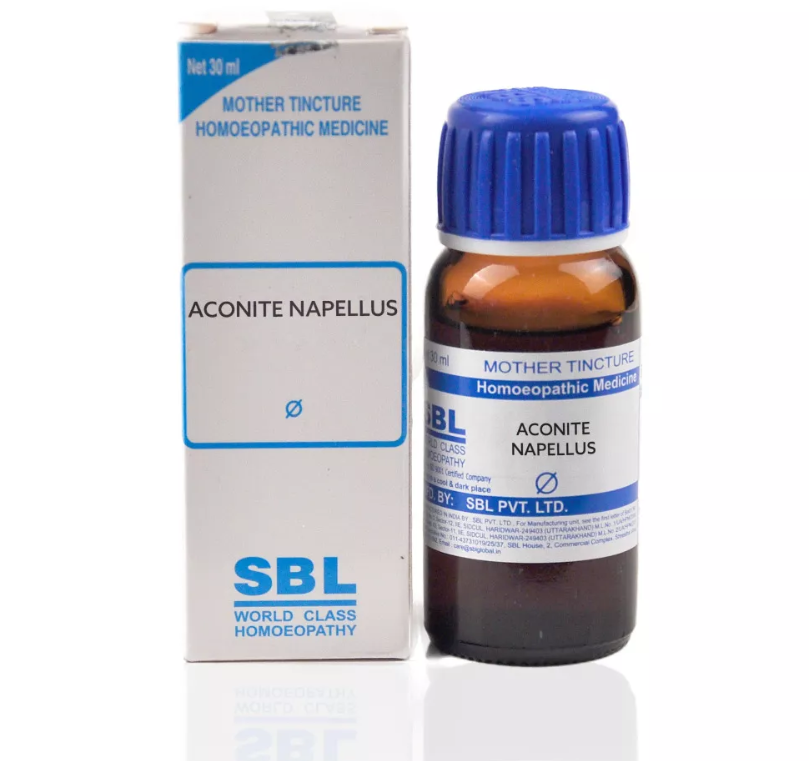Aconitum Napellus Q, 6C, 12C, 30C, 200C, 1M, 10M USES AND SYMPTOMS
 Aconitum Napellus (Monkshood) – The Fearful Storm
Aconitum Napellus (Monkshood) – The Fearful Storm
Acon. A state of fearful unease, where anxiety grips both body and mind. Aconitum reveals itself through sudden, acute violent invasion with fever, refusing touch, and a rapid drain of strength. Triggered by exposure to cold or hot weather, it swiftly addresses inflammatory fevers, targeting serous membranes and muscular tissues. Notably, Aconitum induces only functional disturbances, leaving no evidence of lasting tissue changes.
Mind: Fear and worry shadow every ailment, even the most trivial. Delirium paints a picture of unhappiness, fear, and vivid imagination. Restlessness prevails, accompanied by acute senses and an intolerability to pain and music. Thoughts seem to originate from the stomach, creating a surreal atmosphere.
Head: Pulsating, burning sensations dominate, accompanied by intracranial pressure and a peculiar sensation as if the brain were agitated by boiling water. Vertigo, especially on rising, and hair standing on end or being pulled create a surreal symphony of symptoms.
Eyes: Red, inflamed orbs that feel dry and hot, averse to light. Swollen, painful lids and profuse watering after exposure to cold winds showcase Aconitum’s impact on ocular health.
Ears: Sensitivity to noises, unbearable music, and a hot, painful external ear create an auditory disarray. An odd sensation, as if a drop of water lingers in the left ear, adds to the discomfort.
Nose: Acute sensitivity to smell, painful root of the nose, and a throbbing coryza with bright red blood highlight Aconitum’s influence on nasal health.
Face: A flushed, swollen face, with tingling and numbness in the cheeks, showcases the impact on facial features. Neuralgia, especially on the left side, adds to the complexity.
Mouth: Numb, dry sensations, swollen tongue, and sensitivity of teeth to cold paint a vivid oral portrait. Constant movement of the lower jaw and inflamed gums further mark Aconitum’s influence.
Throat: A fiery throat, constricted and burning, with swollen tonsils, typifies the initial stage of tonsillitis according to Aconitum.
Stomach: Vomiting, accompanied by fear and profuse sweat, a bitter taste, and intense thirst for cold water, highlight Aconitum’s impact on the digestive system.
Abdomen: Tense, tympanitic abdomen, sensitive to touch, with colic relieved by warm soup and a burning sensation in the umbilical region, reveals abdominal distress.
Rectum: Nocturnal itching and stitching pains, frequent small stools with tenesmus, and bleeding hemorrhoids showcase Aconitum’s influence on rectal health.
Urinary: Scanty, painful urine, burning at the bladder neck, and suppression with anxiety mark Aconitum’s impact on the urinary system.
Male/Female: Genital symptoms include crawling and stinging sensations, swollen and hard testicles, and various menstrual irregularities in females.
Respiratory: Aconitum affects the respiratory system with constant pressure in the left chest, hoarse, croupy cough, and sensitivity to inspired air.
Heart: Tachycardia, palpitations, and pain in the left shoulder characterize Aconitum’s influence on the cardiovascular system.
Back/Extremities: Numbness, tingling, shooting pains, and stiffness manifest in the back and extremities. Rheumatic inflammation of joints, especially at night, reflects Aconitum’s impact on the musculoskeletal system.
Sleep/Fever: Sleep disturbances include nightmares, restless sleep, and anxiety-filled dreams. A fever pattern with marked cold stages, alternating coldness and heat, and drenching sweats defines Aconitum’s influence on the sleep and fever realms.
Secondary Symptoms:
Head: Lightness, aching, vertigo, tinnitus, and a tight scalp create additional head symptoms.
Mouth: Slimy mouth, a dirty yellow tongue, and a scalded sensation contribute to the oral discomfort.
Stomach: A heavy weight, gnawing hunger, and a faint feeling in the epigastrium are additional gastric symptoms.
Urinary: Oily pellicle on urine and albuminous, scanty urine mark additional urinary symptoms.
Respiratory: Frequent desire for a deep breath and a sensation of weight on the chest add to respiratory symptoms.
Heart: Mitral and aortic regurgitation, chronic aortitis, and venous engorgement showcase cardiac symptoms.
Extremities: Aching in the nape, stiff and aching spine, and edema contribute to extremity symptoms.
Sleep: Restlessness and horrible dreams add to sleep disturbances.
Relationship: Aconitum shares relationships with Adonidinum, Dig., Crat., Conv., and Stroph-h.
selection of the potency
Individualization:
- Homeopathy is based on the principle of treating the individual, not just the disease. The unique symptoms and characteristics of the person are crucial in determining the most suitable potency.
Intensity of Symptoms:
- The intensity of the symptoms guides the choice of potency. If the symptoms are intense and acute, a lower potency (e.g., 6C, 30C) might be considered. For chronic conditions with less intensity, higher potencies (e.g., 200C, 1M) may be appropriate.
Sensitivity of the Patient:
- Some individuals are more sensitive to homeopathic remedies, while others may require higher potencies. The practitioner considers the patient’s sensitivity when selecting the potency.
Acute vs. Chronic Conditions:
- Lower potencies are often used for acute conditions, while higher potencies may be considered for chronic or long-standing issues.
Previous Response to Potencies:
- The patient’s response to previous homeopathic treatments helps guide the choice of potency. If a particular potency has been effective in the past, it may be repeated or adjusted as needed.
Vital Force and Susceptibility:
- Homeopathy views illness as a disturbance in the vital force. The practitioner assesses the patient’s overall vitality and susceptibility to determine the appropriate potency.
Aggravation or Amelioration:
- The direction of the symptom response (aggravation or amelioration) after taking a remedy can influence the choice of potency.
Miasmatic Considerations:
- In classical homeopathy, the concept of miasms (inherited disease tendencies) is considered. The practitioner take this into account when selecting the potency.
Practitioner Experience:
- The experience and preference of the homeopathic practitioner play a role. Some practitioners may have success with certain potencies based on their clinical experience.
SAFETY INFORMATION
- Do not exceed the recommended dose by physician
- Keep out of the reach of children
- Store in a cool dry place away from direct sunlight
- Maintain half an hour gap between food/drink/any other medicines and homoeopathic medicine
- Avoid any strong smell in the mouth while taking medicine e.g. camphor, garlic, onion, coffee, hing
Medicine images use for reference only selection of homeopathic medicine depends on the individual’s specific symptoms and overall constitution. Moreover, homeopathy is a holistic system of medicine that treats the individual as a whole. In addition to addressing the physical symptoms, it takes into account the emotional and mental state of the person. Consequently, it’s crucial to consult with a qualified homeopathic practitioner for personalized treatment.
The information provided on this website is intended solely for educational purposes. Always seek the advice of your physician or other qualified health provider.
